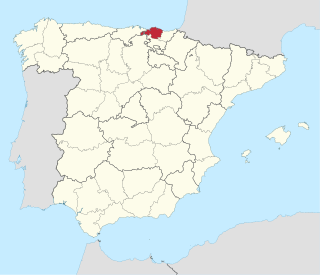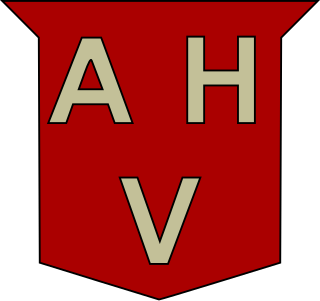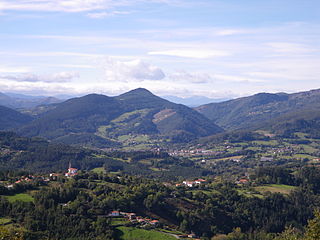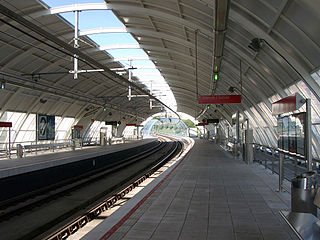
Bilbao is a city in northern Spain, the largest city in the province of Biscay and in the Basque Country as a whole. It is also the largest city proper in northern Spain. Bilbao is the tenth largest city in Spain, with a population of 345,141 as of 2015. The Bilbao metropolitan area has 1,037,847 inhabitants, making it one of the most populous metropolitan areas in northern Spain; with a population of 875,552 the comarca of Greater Bilbao is the fifth-largest urban area in Spain. Bilbao is also the main urban area in what is defined as the Greater Basque region.

Biscay is a province of Spain and a historical territory of the Basque Country, heir of the ancient Lordship of Biscay, lying on the south shore of the eponymous bay. The capital and largest city is Bilbao.

Euskotren Tranbia is the brand under which the tramway networks in the cities of Vitoria-Gasteiz and Bilbao are run. The system in Bilbao started operations in 2002, and the one in Vitoria-Gasteiz in 2008. It is one of the four commercial divisions under which Euskotren operates. The infrastructure is owned by the public entity Euskal Trenbide Sarea and tracks use 1,000 mm narrow gauge.

The River Nervión runs through the town of Bilbao, Spain into the Cantabrian Sea. Its lowermost course, downstream of its confluence with the Ibaizabal River, is known as the Estuary of Bilbao.

Barakaldo is a municipality located in the Biscay province in the Basque Country. Located on the Left Bank of the Estuary of Bilbao, the city is part of Greater Bilbao with a population as of the 2019 census at 100,881;. Barakaldo has an industrial river-port heritage and has undergone significant redevelopment with new commercial and residential areas replacing the once active industrial zones.

Erandio is a town and municipality located in the province of Biscay, in the autonomous community of Basque Country, northern Spain. The name comes from euskera ARANDIO that means plum plantation or field.

Getxo is a town located in the province of Biscay, in the autonomous community of the Basque Country, in Spain. It is part of Greater Bilbao, and has 77,946 inhabitants (2019). Getxo is mostly an affluent residential area, as well as being the third largest municipality of Biscay.

Valle de Trápaga-Trapagaran is a town and municipality located in the province of Biscay, in the autonomous community of Basque Country, northern Spain. It is located near Barakaldo, Portugalete and Ortuella. Iron ore has been mined here since Roman times and the two parts of the municipality, which are at different altitudes, are linked by a funicular railway. According to the 2019 census, it has 11,985 inhabitants.

The left bank of the Estuary of Bilbao is a part of the Greater Bilbao region, its main towns are Barakaldo, Sestao, Santurtzi and Portugalete and in addition to the iron mines, was the heart of the intense industrialisation of Biscay. Thousands of workers from all Spain came to the area during the 19th and the 20th century to work in the major shipbuilding and steel industries like Altos Hornos de Vizcaya and La Naval. Hence it was one of the birthplaces of the worker movement in Spain. The Socialist leader Indalecio Prieto and the Communist Pasionaria found their initial audiences here.
Greater Bilbao is an administrative division of the province of Biscay, in the Basque Country, Spain. It is one of the seven comarcas of Biscay and the most populated one. The capital city of Greater Bilbao is Bilbao.

Altos Hornos de Vizcaya, S.A. was a Spanish metallurgy manufacturing company. It was the largest company in Spain for much of the 20th century, employing 40,000 workers at its height. The business began in 1902 in Bilbao with the merger of three iron and steel businesses: Altos Hornos de Bilbao, La Vizcaya, and La Iberia. In the 1990s, following a series of mergers, it joined with Arcelor.
The Estuary of Bilbao lies at the common mouth of the rivers Nervion, Ibaizabal and Cadagua, which drain most of Biscay and part of Alava in the Basque Country, Spain. In this instance, the Spanish word estuario is used to describe what in English would normally be called part estuary, part tidal river. The estuary becomes a tidal river which extends 16 km (9.9 mi) into the city of Bilbao, starting from the Bilbao Abra bay. It hosts the port of Bilbao throughout its length, although the Port Authority has recently restored most of the upper reaches to Bilbao and other municipalities for their urban regeneration. The port is now being transferred to the seaboard on the coast at Santurtzi and Zierbena.

Enkarterri is a comarca of the province of Biscay, in the Basque Country, Spain. It is one of the seven eskualdeak/comarcas or districts that make up the province of Biscay. Its administrative centre is Balmaseda.

The Merindad de Uribe or Uribealdea is a historical subdivision of Biscay, Basque Country, Spain. It contained most of the municipalities now within the comarca of Greater Bilbao in the Bilbao metropolitan area. The parts of Uribe which now fall under Greater Bilbao are:

Deusto, also known as Deustu in Basque and formerly known as San Pedro de Deusto, is one of the eight districts of Bilbao, (Spain). It is located on the right side of the Bilbao estuary, in the northwestern part of the city and bordering the estuary itself on the south and the southern hillside of Mount Artxanda and Mount Bandera on the north. Deusto was originally an elizate and also a municipality until 1925 when it was completely annexed by Bilbao in order to expand the free land available to the city. Deusto is known as the university district of the city as it is home to the University of Deusto and the Faculty of Economics and Business of the University of the Basque Country.

Abando, formerly known as San Vicente de Abando, is one of the eight districts of Bilbao, Basque Country (Spain). It covers most of the city's centre, located on the left bank of the estuary of Bilbao. It is the only district of Bilbao with all of its land completely urbanised. Abando was originally an elizate and also a municipality until 1876, when part of it was annexed to Bilbao, the rest of the elizate's municipal land was integrated into Bilbao in 1890. In 2016 the population was 50,903. Abando is the wealthiest district in Bilbao, with personal and family incomes being well above the citywide average.

The Basque Country, also called Basque Autonomous Community, is an autonomous community of Spain. It includes the provinces of Álava, Biscay, and Gipuzkoa, located in the north of the Iberian Peninsula, bordering on the autonomous communities of Cantabria, Castile and León, La Rioja, and Navarre, and the French region of Nouvelle-Aquitaine.

Line 2 of the Bilbao metro is a rapid transit line in Biscay, Basque Country, Spain. It runs from Basauri to Kabiezes. Its route covers the municipalities of Basauri and Etxebarri, the city of Bilbao and the left bank of the Nervión river. The line has 25 stations.

The Bilbao Metropolitan Area is the metropolitan area or continuous urban area based around the city of Bilbao, in the Basque Country, Spain. It comprises the city of Bilbao, the 25 municipalities that make the comarca of Greater Bilbao plus ten other surrounding municipalities, all of them in the province of Biscay.

The autonomous Community of the Basque Country within Spain contains several comarcas or eskualdeak in the Basque language, referring to local districts, grouped into its three long-established provinces.


























